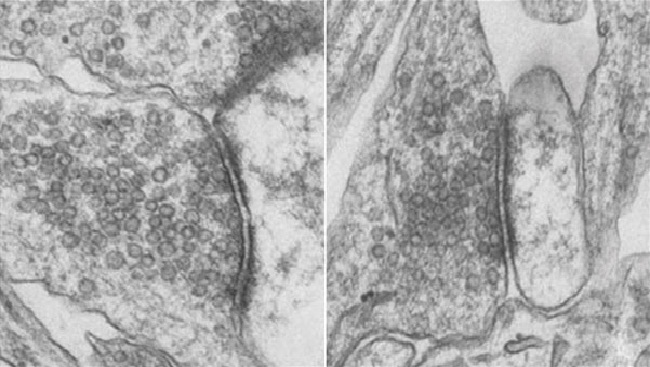Animal Research Success: The Brain's Chemical Code
- Published9 Mar 2012
- Reviewed9 Mar 2012
- Author Emily K. Dilger, PhD
- Source BrainFacts/SfN
Think of your brain as an intricate highway, with pathways and connections to its different areas. Neurons, or nerve cells, can send and receive messages along these pathways, making contact with other neurons at synapses. The synapse is the target for treatments for a range of brain disorders, from Parkinson’s disease to attention deficit hyperactivity disorder (ADHD).

Brain chemicals, called neurotransmitters, are packaged in tiny, bubble-like compartments known as vesicles. This image shows vesicles at the end of one brain cell that are ready to cross a small gap into another brain cell.
Starting back in the 1960s, studies using rats and mice led to discoveries that allowed scientists to visualize neurons that contained and used specific neurotransmitters. To do so, scientists made use of proteins able to attach to and identify specific substances in the brain. This enabled scientists to look at the brain's pathways and connections, as well as the neurotransmitters different areas of the brain use to communicate with each other. From there, they were able to draw a roadmap of the brain's connections, a process called circuitry mapping. Over time, these techniques were applied to examinations of the nervous systems of humans who had died.
Identifying how the brain functions normally and how disturbances in cell communication can lead to brain disease is a major development in modern neuroscience. For example, work on a specific type of neurotransmitter, catecholamines, led to the discovery that a decrease in these neurotransmitters in the prefrontal cortex – an area important in forethought and behavior – can result in ADHD. This finding led to the development of medications that increase catecholamine communication.
By targeting synapses, scientists have been able to treat psychiatric disorders, including schizophrenia and depression, as well as neurodegenerative disorders such as amyotrophic lateral sclerosis (ALS), and Parkinson’s disease. In particular, the finding that neurons containing the neurotransmitter acetylcholine die during Alzheimer's disease has deepened our understanding of this ailment.
CONTENT PROVIDED BY
BrainFacts/SfN
Also In Archives
Trending
Popular articles on BrainFacts.org


















